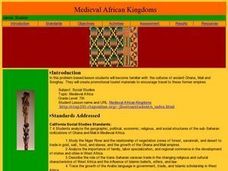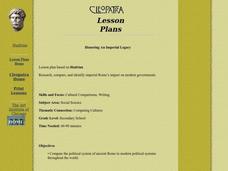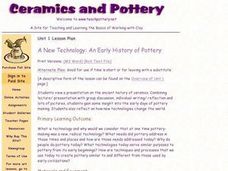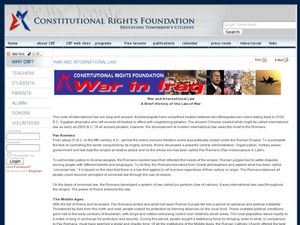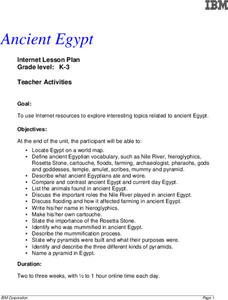Curated OER
Remains of the Day
Learners consider how archaeologists discovered and pieced together artifacts that indicate a Celtic presence in ancient Turkey. They research ancient civilizations and create archaeological digs containing items representative of these...
Curated OER
Talking Rocks
Third graders explain the difference between Petroglyphs and Pictographs from Ancient Native American peoples. They create symbols that are representative of a story about their world.
Curated OER
The Warrior Role in Greek Society
High schoolers are introduced to the various gods and goddesses in ancient Greek mythology. In groups, they use print and electronic resources to research the ways Greek culture has influenced the modern world. To end the instructional...
Curated OER
Medieval African Kingdoms
Seventh graders examine the geography and political history of West Africa. They role-play as applicants to a company that transports customers to any historic time period. Working in teams, they create promotional products encouraging...
Curated OER
Three Little Pigs and Heat Transfer
Students use the Internet to research the ancient practices of building structures and to help them recognize what building materials serve as good conductors and insulators of heat. They build a structure using straw bale walls.
Curated OER
Dry-Land Kalo-Growing New Plants from Stems
Students explore Hawaiian plants. In this Hawaii culture and botany instructional activity, students plant the haha(stem) of a taro plant. Students listen to Hawaiian myths about the taro plant and chorally speak a Hawaiian chant of...
Curated OER
The Royal Cubit
Pupils explore the history of measurement in ancient Egypt. For this math lesson, students discuss the development of a standardized measurement system. Pupils measure using various units and discuss the results and the need for a...
Curated OER
Icon Adoration: The Byzantine Empire
Students study idol worship in the Byzantine Empire and the separation it cause between the Roman Catholic and Orthodox churches. In this Byzantine Empire lesson plan, students study pictograph transparencies and take a pop quiz over...
Curated OER
Honoring An Imperial Legacy
Students research, compare, and identify imperial Rome's impact on modern governments. They compare the political system of ancient Rome to modern political systems throughout the world.
Curated OER
How Tall Is That Flag Pole?
Students examine various triangles and discuss how similar triangles have sides that are proportional. They utilize an ancient Egyptian method to determine the height of a flagpole.
Curated OER
The Growth of River Civilizations
In this social studies worksheet, learners are directed to conduct Internet research at a specified site. Students answer 4 essay questions about river civilizations in ancient Egypt.
Curated OER
A New Technology: An Early History of Pottery
Students view a presentation on the ancient history of ceramics and gain insight into the early days of pottery making. They also reflect on how new technologies change the world.
Curated OER
The History of Dentistry
Students explore about dentistry's ancient roots and modern history. They read a brief history and answer questions on a comprehension work sheet. Also, students explore dentistry by reading the Historical Overview on the History of...
Curated OER
Europe – Religion and Reformation
Ninth graders examine the Reformation. In this European history lesson, 9th graders explore the 95 theses of Martin Luther and discuss the reaction of the Roman Catholic Church to his ideas. Students then take a quiz based on the lesson.
Curated OER
Contributions of Ancient Egypt and China
Second graders study the contributions of Ancient Egypt and China, which have had an impact on world history, with emphasis on written language, laws, calendars, and architectural monuments such as the Pyramids and the Great Wall of China.
Curated OER
War and International Law: A Brief History of the Law of War
Learners investigate the history of the law of war. In this international law lesson plan, students listen to a lecture regarding the history of international law spanning from Pax Romana to Collective Security. Learners respond to...
Curated OER
Mythopoly: Where in the World Is Odysseus?
Learners study Greek mythology. Among other activities, they evaluate a work of art and discuss the influence, significance, and history as it pertains to mythology. As a culminating activity they create a board game that shows their...
Curated OER
Roman and Early Christian Art
Third graders explore pattern, texture, balance, symmetry as they examine Roman and Byzantine art in the four lessons of this unit. Details of the major art works studied are placed into a booklet for presentation to the class.
Curated OER
A Trip Back in Time
Second graders, through the following 10 lessons, develop an understanding of what life was like in Ancient Greece.
Curated OER
Ancient Civilizations
Pupils examine the institutions and values of various ancient civilizations. They define civilization, read and discuss text, write journal entries, list the characteristics of a powerful society, and write a description of an event.
Curated OER
The Silk Road
Students research the geography of Asia from Xian to Istanbul. They explore the intricacies of ancient trade, including trade goods and policies. They study minorities within and outside of various Chinese and other Asian empires.
Curated OER
Religion: Great Schism Debate
Students examine the Great Schism in the Roman Catholic Church and research the positions of the three popes. The three groups research their popes' positions and then hold a debate. Students write position papers about the Great Schism.
Curated OER
Civilizations: Expansion And Conquest
Students determine how the Roman Republic and the Roman Empire acquired so much land. In this ancient civilizations lesson, students watch "Civilizations: Expansion and Conquest." Students then discuss when and how the expansions took...
Curated OER
Ancient Egypt
Students use the internet to research topics on Ancient Egypt. They practice using new vocabulary and identify the types of food they ate and clothing they wore. They explain the role of the Nile as well.





